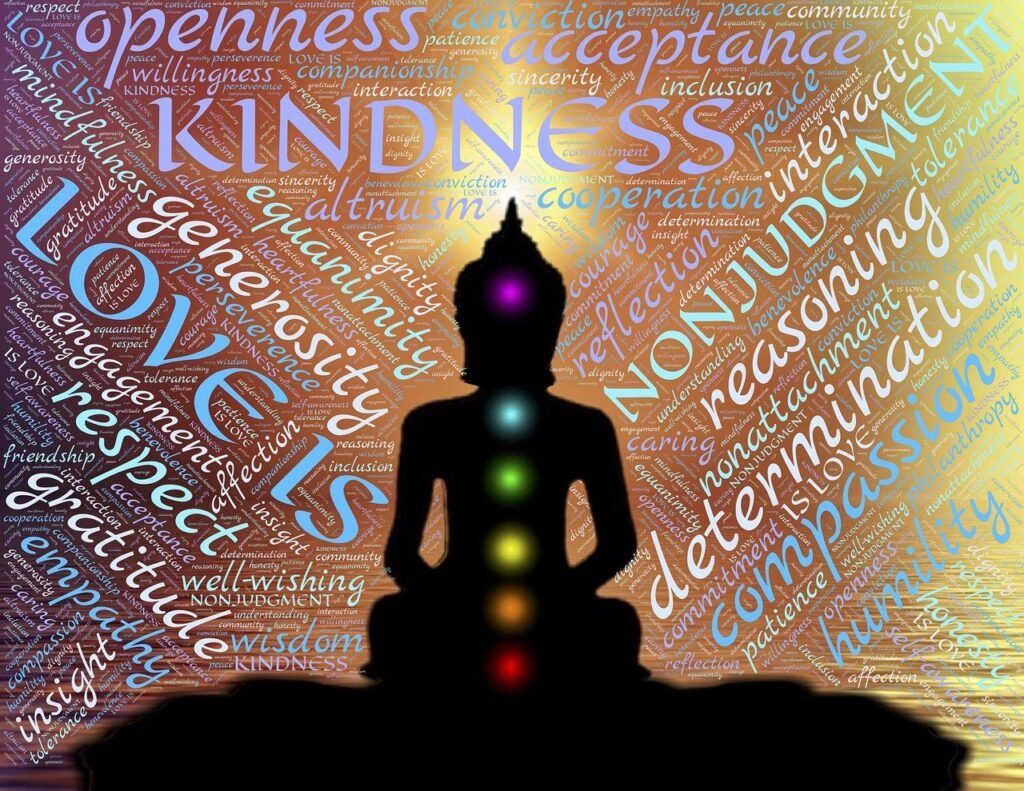
Image by John Hain via Pixabay
In the stillness of meditation, a simple wish arises: May you be happy. May you be safe. May you be free of suffering. This is Metta, or loving-kindness – an ancient practice of boundless compassion that gently expands the heart. What was once taught by poets and monks as a path to inner peace is now being illuminated by modern science. As researchers peer into the mind and body, they find that cultivating loving-kindness can profoundly enhance our emotional well-being, reshape our brains, and even strengthen the social fabric that connects us all. The wisdom of the heart, it turns out, is also medicine for the mind.
Psychological Benefits: A Happier, Calmer Mind
Metta meditation is often described as a balm for the weary heart – and psychology is discovering just how true that is. In practicing loving-kindness, we generate feelings of goodwill and warmth toward ourselves and others. This simple shift of mindset can produce remarkable emotional benefits. In a landmark study, participants who practiced seven weeks of loving-kindness meditation reported significant increases in positive emotions – love, joy, gratitude, hope, and more – and these gains in positivity led to increased life satisfaction and reduced depressive symptoms (18 Science-Backed Reasons to Try Loving-Kindness Meditation | Psychology Today). In essence, training the heart in kindness lifts the cloud of negative emotion and brightens one’s overall mood.
Importantly, loving-kindness doesn’t only amplify what’s positive; it also soothes what’s painful. By sending gentle wishes of peace and wellness, people often find their own anxieties and angers begin to soften. Clinical observations support this calming effect – for example, in one pilot trial with chronic pain patients, those who practiced loving-kindness meditation for 8 weeks showed greater decreases in anger, anxiety, and psychological distress compared to those receiving standard care . And even individuals grappling with severe trauma have found relief: war veterans completing a loving-kindness program experienced significant drops in PTSD and depression symptoms (18 Science-Backed Reasons to Try Loving-Kindness Meditation | Psychology Today). It’s as if the compassion we extend outward also washes inward, quieting the mind’s turmoil.
Over and over, studies converge on a simple truth: nurturing benevolence within ourselves makes us emotionally more resilient. People report lower stress and a greater sense of calm after cultivating Metta. In fact, a broad review of meditation practices concluded that loving-kindness and compassion meditations are consistently linked with increased positive affect and reduced negative affect – essentially, more frequent feelings of happiness and fewer moments of anger, sadness, or worry ( Loving-Kindness and Compassion Meditation: Potential for Psychological Interventions – PMC ). By practicing kindness, we aren’t denying life’s difficulties; rather, we’re training our minds to meet those difficulties with gentle strength and a caring attitude. The result is a happier, calmer inner life.
Neuroscience: Rewiring the Brain for Empathy and Peace
What happens in the brain when the heart overflows with kindness? Neuroscientists have begun to capture glimpses of this neural magic, and the findings are inspiring. When we practice loving-kindness, we are literally training our neural pathways in much the same way that practicing an instrument trains our musical skills. In one pioneering brain-imaging study, participants (including both seasoned monks and novices) generated feelings of compassion while in an fMRI scanner. The scans revealed that meditation on loving-kindness can markedly change the brain circuits involved in empathy and emotion – in fact, these changes were so pronounced that the researchers likened it to seeing how practice can rewire the brain, a striking example of neuroplasticity (Study shows compassion meditation changes the brain). In other words, compassion is a skill the brain can learn; as we exercise it, the brain’s empathy centers light up and strengthen over time.
Regularly sending out wishes of goodwill appears to “exercise” key regions of the brain. Modern neuroscience has shown that loving-kindness meditation activates and strengthens areas of the brain responsible for empathy and emotional regulation (18 Science-Backed Reasons to Try Loving-Kindness Meditation | Psychology Today). For example, the prefrontal cortex – a region behind the forehead associated with attention, self-control, and empathy – shows increased activity during compassion meditation, reflecting our mindful focus and concern for others. Likewise, parts of the limbic system, which governs emotion and connection, become more responsive, indicating that we are tuning our brain to resonate with warmth and care. Even the physical structure of the brain can be altered: studies have found increases in gray matter volume in regions related to emotion regulation among people who practice loving-kindness consistently (18 Science-Backed Reasons to Try Loving-Kindness Meditation | Psychology Today). It’s as if, through loving-kindness, we nurture the “muscles” of the mind that generate kindness, literally growing our capacity for empathy.
This mind-heart training doesn’t stop at the brain – it extends into the body’s nervous system as well. One of the most fascinating findings in the science of Metta involves the vagus nerve, a major nerve that runs from the brain through the heart and into the gut, orchestrating our relaxation response and feelings of connectedness. Practicing loving-kindness has been shown to boost “vagal tone,” a measure of the vagus nerve’s healthy activity. In one study, individuals who engaged in a loving-kindness meditation program exhibited increases in vagal tone, which corresponded with greater positive emotions and stronger feelings of social connection (18 Science-Backed Reasons to Try Loving-Kindness Meditation | Psychology Today). Essentially, by generating compassion, we activate the body’s calming pathways – heart rate slows, stress hormones decrease, and we experience a gentle warmth in the chest that scientists call the relaxation response. Indeed, even a brief 10-minute session of Metta meditation can shift our physiology toward calm: researchers observed an immediate increase in respiratory sinus arrhythmia (a sign of parasympathetic, “rest-and-digest” activity) and a slower breathing rate after just one short loving-kindness practice (18 Science-Backed Reasons to Try Loving-Kindness Meditation | Psychology Today). This is the biology of peace taking root. The brain and the body, the mental and the physical – all are touched and transformed by the simple act of caring intention.
Sociological Perspectives: Compassion and Connection
No person is an island; our well-being is interwoven with the love and understanding we share in our relationships and communities. Loving-kindness meditation, while practiced in the solitude of one’s mind, carries profound ripple effects into our social world. As we foster compassion within, we naturally begin to radiate it outward, strengthening the bonds between us and others. Science is now affirming that Metta can act as a social glue, binding individuals together with threads of empathy, kindness, and reduced prejudice.
One striking experiment asked: Can we actually generate feelings of connection toward complete strangers? The answer was yes. In that study, participants were led through just a few minutes of loving-kindness meditation in a controlled setting. Amazingly, even a single brief session of wishing others well significantly increased people’s feelings of social connection and positivity toward new individuals they had never met (Loving-kindness meditation increases social connectedness – PubMed). Those who did a kindness meditation, compared to a neutral task, felt more connected and less isolated – suggesting that the heart, when opened, reaches farther than we might imagine. This aligns with what many practitioners report: that cultivating compassion inside makes the world around you feel richer in trust and friendship.
Over longer periods, the social impact of loving-kindness becomes even more evident. People who regularly practice Metta often display more empathy, kindness, and altruism in their daily interactions. For instance, research found that those trained in loving-kindness meditation became more likely to help others in need during experimental game scenarios, indicating greater altruistic behavior after cultivating compassion . In another study, individuals who practiced loving-kindness showed heightened empathic responses to the suffering of others – they could tune into others’ emotions more deeply – yet they also maintained a kind of emotional balance, experiencing warm feelings rather than personal distress in the face of others’ pain (18 Science-Backed Reasons to Try Loving-Kindness Meditation | Psychology Today). This suggests that Metta fosters a mature empathy: the ability to care with others without being overwhelmed.
Perhaps most inspiring, loving-kindness might even help bridge societal divides. In our world, prejudice and biases often underlie conflict – but here too, compassion meditation shows promise. A recent experiment found that after six weeks of regular loving-kindness practice, people exhibited significantly reduced implicit bias towards minority groups (18 Science-Backed Reasons to Try Loving-Kindness Meditation | Psychology Today). In essence, training the mind in universal goodwill helped dissolve some of the subtle, unconscious prejudices that keep us separated. By learning to see all beings through the eyes of kindness, the practitioners became less prone to “us vs. them” thinking. Imagine the implications: if enough hearts are softened, the collective fabric of society could become more inclusive and harmonious. We might see less loneliness, as more individuals reach out in friendliness; less aggression, as empathy tempers judgment; and greater cooperation, as our fundamental interconnection is felt more clearly. Loving-kindness starts in the privacy of one’s mind but does not end there – it blossoms into outward actions and attitudes that can make our communities more compassionate places.
Practical Applications: Bringing Loving-Kindness into Daily Life
The science is convincing: practicing loving-kindness offers real benefits for mind, brain, and society. But how can one integrate this practice into the hustle and busyness of modern life? The beauty of Metta is that it is both simple and accessible – it doesn’t require special equipment or hours of time, only a willing heart and a few minutes a day. Research suggests that even small doses of loving-kindness can be effective. In fact, one study noted that even a single short session (under 10 minutes) of loving-kindness meditation produced a measurable increase in positive feelings and social connection (18 Science-Backed Reasons to Try Loving-Kindness Meditation | Psychology Today). The key is consistency and sincerity. By making loving-kindness a gentle daily habit, we gradually accumulate its benefits, much like watering a plant a little every day helps it bloom. Many participants in studies continue the practice well after the study ends, inspired by how it makes them feel – one follow-up found that over a third of people kept meditating and maintained higher positive emotions more than a year after a loving-kindness program, with those who practiced more frequently reporting the greatest gains (18 Science-Backed Reasons to Try Loving-Kindness Meditation | Psychology Today). In short, the more love you give, the more grows within you.
Here are a few simple, research-backed steps to nurture loving-kindness in your daily routine:
- Start with a Pause: Set aside a quiet moment each day, even just 5–10 minutes. Sit comfortably, close your eyes, and take a few deep breaths. Allow your body and mind to relax. Consistency matters more than duration, so aim for a regular daily practice, however brief. (Even short sessions engage your relaxation response and build the habit.)
- Cultivate Self-Compassion: Begin by directing kind wishes toward yourself. This isn’t selfish – it builds a foundation of inner goodwill. Silently repeat gentle phrases with mindful intention. For example: “May I be happy. May I be healthy. May I be safe. May I live with ease.” As you say these words, try to truly feel the warmth behind them. If it helps, visualize yourself bathed in a warm, golden light of compassion. Let any self-judgment melt away in that light.
- Extend to Loved Ones and Beyond: Next, bring to mind someone you care about deeply – a dear friend or family member. While holding their image in your heart, offer the same wishes: “May you be happy, healthy, safe, and at ease.” Feel the natural love you have for them and send it their way. Then, gradually expand the circle: think of a neutral person (perhaps an acquaintance or a stranger you noticed today), and extend kind wishes to them. Finally, if you can, even include someone you have difficulty with – offering kindness to them as well, as a way of unburdening your own heart. Traditional teachings suggest this widening sequence from self, to loved ones, to acquaintances, to all beings (Frontiers | The effect of loving-kindness meditation on positive emotions: a meta-analytic review). You might be surprised at how challenging yet freeing it is to offer goodwill to everyone, without distinction. Take it at your own pace – even the intention to cultivate universal kindness is powerful.
- Visualize and Radiate: As you send out these wishes, some people find it helpful to use visualization. You might imagine the person you’re focusing on smiling and well, or picture a soft light connecting your heart with theirs. If your attention wanders (and it will), gently bring it back to the phrase or image. The act of repeatedly returning to kindness is like training a puppy – with patience and gentle persistence. Over time, this mental exercise strengthens your capacity to care. Neurological research confirms that this kind of focused compassion exercise activates brain networks for empathy and emotional understanding (18 Science-Backed Reasons to Try Loving-Kindness Meditation | Psychology Today), so you are literally reshaping your mind toward kindness with each repetition.
- Integrate Kindness into Daily Life: Formal meditation is wonderful, but loving-kindness can also be a way of life. Throughout your day, look for small opportunities to practice compassion informally. While waiting in line, you might silently wish the people around you well. When you feel stressed by someone’s actions, take a breath and recall that they, too, wish to be happy and free of suffering – just like you. This perspective can transform your interactions. You might also perform simple acts of kindness: a sincere compliment, a helping hand, or listening attentively. Such acts reinforce the positive feedback loop that loving-kindness meditation starts in the brain and heart. Over time, the boundary between “meditation” and “life” blurs – kindness becomes a natural reflex. And as studies on social connection show, these habits will not only brighten someone else’s day but also nurture your own sense of belonging and purpose (Loving-kindness meditation increases social connectedness – PubMed).
In practicing Metta daily, remember that it’s normal to have days when warm feelings don’t come easily. You might encounter emotional resistance or numbness at times – that’s okay. The practice is not about forcing emotions, but about planting seeds. Some days you water those seeds with intention, and nothing obvious sprouts immediately. Other days, unexpectedly, you might feel a profound sense of peace and connection washing over you. Trust that under the surface, the seeds of kindness are taking root. The science we’ve explored – from increased positive emotions and reduced anxiety to strengthened neural pathways and social bonds – assures us that changes are happening, often subtly, with each attempt. Be patient and gentle with yourself in this journey.
Embracing the Warmth of Metta
As we weave together the poetic wisdom of loving-kindness with the empirical insights of science, a beautiful picture emerges: kindness is a force for healing. It heals us internally by alleviating stress, anxiety, and loneliness, and it heals between us by nurturing empathy, understanding, and unity. A meditation that begins with soft phrases in the silence of your mind can ripple outward to brighten your mood, rewire your brain, touch the heart of a stranger, and perhaps even expand the circle of human compassion. Modern research validates these effects (18 Science-Backed Reasons to Try Loving-Kindness Meditation | Psychology Today) (Loving-kindness meditation increases social connectedness – PubMed), but perhaps we ourselves become the most compelling evidence.
In the end, Metta is more than a practice – it is a way of being. Each time you close your eyes and send warm wishes into the world, you are, in a very real sense, lighting a small candle in the darkness. And study by study, and heart by heart, we see that these candles can illuminate even the darkest corners of our minds and our communities. May you be happy. May you be healthy. May you live with ease. Such simple words, carrying such profound power. In embracing loving-kindness, we discover that the love we give is not lost – it returns to brighten our own path, creating an upward spiral of well-being (18 Science-Backed Reasons to Try Loving-Kindness Meditation | Psychology Today). This is the gift of Metta: a compassionate heart, grounded in wisdom, radiating healing to self and others, and guided both by ancient truth and modern science toward a more loving world.


